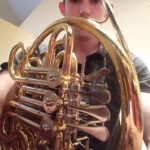WindWorks Trumpet Academy › Forums › WindWorks › Struggling with the basics
Tagged: Conclusion:
- This topic has 12 replies, 7 voices, and was last updated 1 year, 11 months ago by
hello.richard.
-
AuthorPosts
-
-
19 February 2021 at 5:08 am #73371
 hugo.sParticipant
hugo.sParticipantHi!
Decided to get back on the MTM-train. Have had two lessons with Greg and worked with MTM on and off for around three years, but not so much lately.
I thought that I should post a video here to the forum since I’ve seen other members do the same, and get all kinds of good advice. My problem is that while I feel that I can do the exercise with visualizer and tissue just fine, the notes won’t center and I don’t get a good sound on the trumpet (and I have no range). I guess I am changing something but I don’t know what.
Any tips?
//Hugo
-
19 February 2021 at 9:27 am #73383
 Ronald CarsonParticipant
Ronald CarsonParticipantHi Hugo,
I am always struggling with the basics. I continue doing the WindWorks methods, and I always start having problems. So I briefly return to the beginning. I begin with breathing, concentrate on my aperture corners, and stop playing beyond my MTM mastery level range. Mostly, I come back stronger. A few months later, I start again. If that sounds demoralizing, it doesn’t have to be your story.I am not sure of your microphone’s quality. Your sound is not as brassy and clear as I would like. It all starts with the backswing. You seem to be taking a very little backswing. Watch the backswing videos again. Practice just the inhalation and the release without a visualizer. The tissue will pop away. You can’t have much passive reduction if you don’t start without taking the concert hall breath.
Do the visualizer again with the concert hall breath. Then try it with the mouthpiece and then the lead pipe. The air will interact with your lips to create a ringing trumpet sound.
Cheers,
Ronald-
19 February 2021 at 9:50 am #73385
 Ronald CarsonParticipant
Ronald CarsonParticipantAlso, do aah-oow before to form your embouchure. Discovering your aperture corners is important. You may feel like you get it, but this is why I have to go back to start so many times. I learned to play 49 years ago without private instruction. I think my problems concern manipulating lips and horn to get less than pure results. There has to be a proper amount of positive tension in the corners. It sounds to me like there might be a tad inconsistency there. This is where I also need consistency. The aperture corners and other factors of shape determine pitch and resonance. Of course, these mean nothing without fuel. Air is our fuel.
-
-
20 February 2021 at 4:26 am #73435
 hugo.sParticipant
hugo.sParticipantThanks a lot for your input! Some good advice there. Haven’t really focused on the backswing at all lately, but will now, definitely.
The aperture corners still eludes me though. How do you work on finding them? The ah-oh seems a bit too wide for me, and I’m not sure I actually move the corners in horizontally, but instead get more vertical movement.
(I should say also concerning the sound that I’m using a cup mute, I realize now that it actually isn’t in the shot. Though I think you are right still about the sound not being brassy, I had the same comment from Greg himself! :))
//Hugo
-
20 February 2021 at 6:14 am #73440
 Ronald CarsonParticipant
Ronald CarsonParticipantHa, the cup mute explains the sound.
Yes, the aah-oow will make a wider aperture than you need. It is establishing the corners and is the opposite of clamping the lips. Greg even suggests that big aperture would be best suited for playing pedal tones. One of the exercises for developing corners is to form the aah-oow around the tip of the little finger. You hug the tip of the little finger from the corners. Be sure not to clamp vertically. You can see this demonstrated in Greg’s compilation of the Foundation level (https://mysterytomastery.com/lesson/the-foundation-level/). Go to timestamp 3:15. There is the first aperture exercise, which is followed by the little finger exercise at 3:22. I believe these are in different lessons. It is probably best to follow sequentially through the lessons.
-
20 February 2021 at 6:17 am #73441
rene.avontuur
ParticipantHi Hugo,
I just compared the frequency spectra of your recordings with the long-C-note audio recordings of Grec. The most prominent difference is right after the attack. In Grecs spectra I saw only the distortions caused by the metronome in the background. While your spectra contain clear visible distortions. Based on my own experience and experimenting: installing an audio spectrum analyzer on a smartphone is easy to do. The direct feedback of such an analyzer while playing makes it easier to find a way to reduce these distortions. The brass effect is stronger when playing louder according to the physics of a trumpet. It is fun to visualize this effect as an exercise with a spectrum analyzer. On my old beginners trumpet this effect is also much weaker when comparing with Grecs recording. I am not sure if this is due to my skills or a limitation of my trumpet.René
-
20 February 2021 at 1:21 pm #73465
johnelwood
ParticipantYou look and sound good to me, Hugo, but I agree your breath could be bigger/better.
What helped me find the corners was thinking (oooohhhhh)as I set my lips on the mouthpiece.
If you have good air that you release freely through the aperture into the instrument, you want to experiment with slight changes in your “Shape” that make your sound better (more resonant) on constant air.
If you change the Air and Shape, it will be chaos–you must work on one, then the other, in my opinion.
Then, looking for efficiency–what Shape allows you to change pitch (going up) from one pitch to the next in a harmonic series (open, 1 valve, 2 valves, etc.) with the least amount of movement AND best quality sound on good, but Passively released Air?
That’s what helped me. Hope that helps you. Keep the faith.
-
23 February 2021 at 1:46 am #73668
 hugo.sParticipant
hugo.sParticipantHello again, and a big thanks to everyone. Such helpful advice. This forum is really one of the big perks with WindWorks, hats off to Greg for that one!
Will try all the exercises mentioned, as well as downloading an audio spectrum analyzer. Never thought of that – seems really smart!
Will probably post another video later where I try playing a bit higher.
Anyways, thanks again!
//Hugo
-
25 February 2021 at 7:14 am #73871
ab-hoffman
ParticipantHi Hugo,
I agree the Ah-ooh without bringing any tension to the aperture corners is quite wide. As Greg says it’s about the size used for pedal tones. Also Greg says the only good tension is at the aperture corners. Visualize your aperture as a diamond shape, slightly flattened and bring tension to the aperture corners. This will bring the corners in from the sides and push the center of the lips slightly forward. This is all done inside the cup of the MP. You should strive to feel it happening. I was told along time ago from someone I don’t remember that if you play the leadpipe alone with the correct set, that you should be close to sounding a written first space F on the B-flat trpt. It has worked for me for years.Good luck,
Brian -
4 March 2021 at 3:22 am #74440
 hugo.sParticipant
hugo.sParticipantHey, ab-hoffman, that visualization with the diamond is really nice. Greg should bring that in somewhere, it really gives a good “feelmage” of the aperture I think!
//Hugo
-
17 June 2021 at 6:25 am #84758
 xandar121Participant
xandar121ParticipantHi!
I want to ask you a question,and I want you to answer it:
did you notice something on video?
If not, I think I know what you’re doin’.
You’re doing very good with the visualiser and tissue, but when you pick up the trumpet, your old habits start to kick in. But don’t worry,the fact that you are doing good with the visualiser is already good news, don’t neglect the progress you make!
And now , let’s analyse in detail , shall we?
https://photos.app.goo.gl/dixL7b22X44mKXKN8
1. In the images 1-3 ,where you use the visualizer, everything looks normal to me. Even when you pick up the trumpet and breathe in , the embouchure has no problems ( images 4,5,6 ). Good job on that.
2. Image 7 , that is the moment you start to let the air go and make sound. Still, no problem if you compare image 7 to images 1,2,3.
3. And here it is. Images 8 and 9 ,that’s after a very short time ( a milisecond idk?), we see changes in the lips, especially upper lip , which kind of draws down and inward. That is the moment when your habits start to say hello.
On the video is more clear, but even here, if you watch and compare your upper lip in the images 1 and 8,9. In first image your upper lip RED is huge ,and in images 8 and 9 it seems to be much much smaller , after the change.My 2 cents:
1.Be aware what you do with visualiser when blowing the tissue, repeat many times.
2. Then take the mouthpiece and do exatctly same thing, and look for the same feeling.
3. Then with the mouthpiece on your face,slide it into the trumpet (while blowing)
( P.S: These tips are what Greg said in his begginer videos.)
Don’t rush taking the trumpet when you practice. Feel your body,listen what it speaks to you.Conclusion:
You’re on the right path if you can blow the tissue. That is something good,don’t be upset. Take a positive atitude. You will succeed if you listen carefully to the master Greg.
If you post another video,let me know 😉
-Dan. -
19 June 2021 at 7:10 pm #85093
 hugo.sParticipant
hugo.sParticipantWow, thanks a lot for the very detailed answer! Great stuff in there, and I definitely think you’re on to something with the pictures. I’ll look in to it more and come back with another video hopefully 🙂
/Hugo
-
22 May 2022 at 12:59 pm #139407
hello.richard
ParticipantHi Hugo – I just joined M2M a week ago and saw this post. Could you share with me your progress since then? I think I’m experiencing similar situation as you were in.
-
-
AuthorPosts
- You must be logged in to reply to this topic.
Recent topics
-
1.O / 2.0 routine
by
jice.gif
1 month, 4 weeks ago -
Abdominal surgery and time off the trumpet
by
DQ
6 months, 2 weeks ago -
Allegro or Presto Practice Routine
by
djm297
7 months, 1 week ago -
Tongue lock – Throat lock
by
Ivo Carrabs
8 months ago -
Mouthpiece placement and shape
by
Ivo Carrabs
7 months, 3 weeks ago

